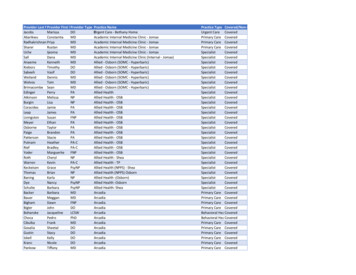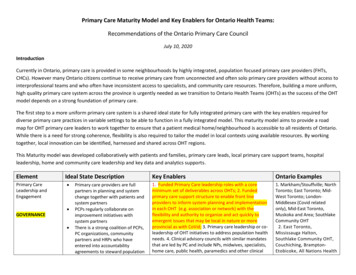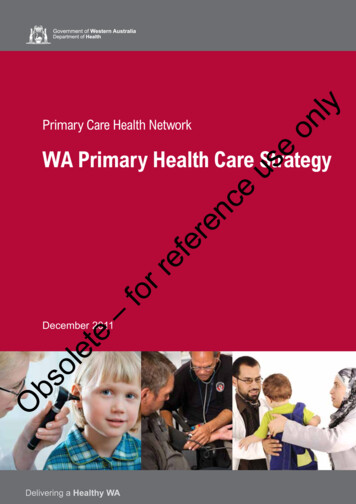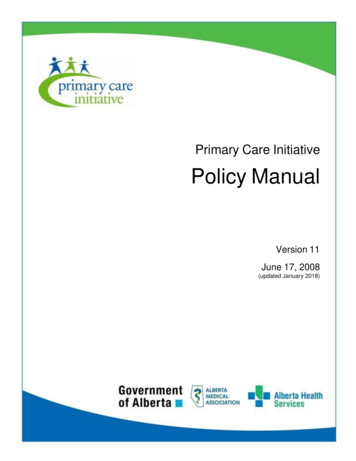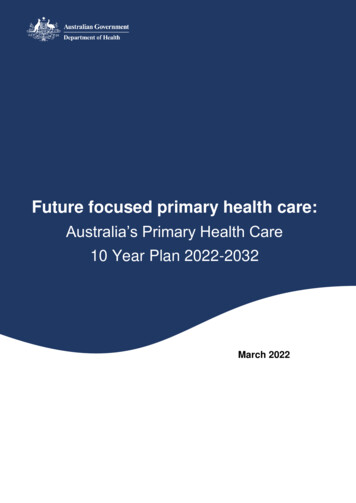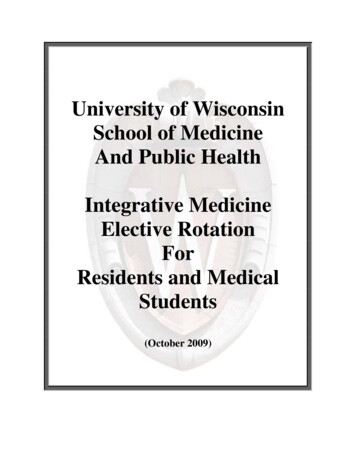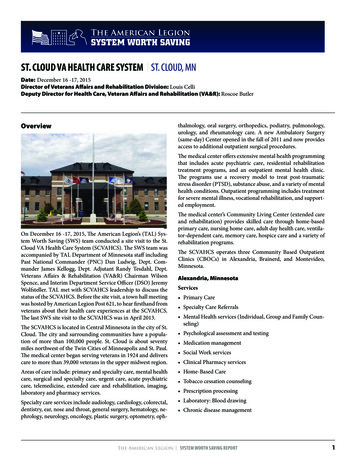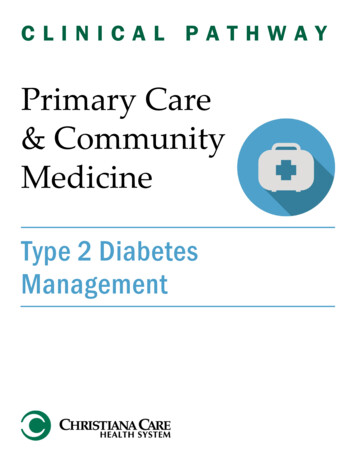
Transcription
CLINICAL PATHWAYPrimary Care& CommunityMedicineType 2 DiabetesManagement
CLINICAL PATHWAY: PRIMARY CARE & COMMUNITY MEDICINEJUNE 23, 2016Type 2 Diabetes ManagementTable of Contents (tap to jump to page)INTRODUCTION1Scope of this Pathway1Pathway Contacts1What is a Clinical Pathway?2CLINICAL PATHWAYWhy Focus on Diabetes?Table 1: Treatment GoalsTable 2: Approximate Comparison of HbA1c and Plasma GlucoseTable 3: Oral Agents and Non-Insulin Injectable MedicationsTable 4: Insulin ProfilesTable 5: Forced Weekly Insulin Titration Schedule (For Treat-To-Target FBG of 120 MG/DL)Table 6: SGAS and Metabolic Abnormalities NewPATHWAY ALGORITHMSAlgorithm 1: Screening & DiagnosisAlgorithm Notes4451024293235393940Algorithm 2: (a) Diabetes ScreeningAlgorithm 3: (b) Investigating Abnormal ValuesAlgorithm 4: (c) Prediabetes404041Algorithm 5: (d) Criteria for Diabetes DiagnosisAlgorithm 6: (e) Antibody TestingAlgorithm 7: Monitoring HBA1C414142Algorithm 8: Diabetes Self-Management Education & Support for Adults with Type 2 DiabetesAlgorithm 9: Treatment of Type 2 Diabetes — A Patient-Centered ApproachINZAlgorithm 10: Initial Physiologic Insulin Regimen434648Algorithm: Patient VisitAlgorithm 11: Patient Rooming (Medical Assistant or Patient Care Tech)Algorithm 12: Patient Visit (Primary Care Provider)494950HEALTH DISPARITIES51PATIENT EDUCATION MATERIALS52
CLINICAL PATHWAY: PRIMARY CARE & COMMUNITY MEDICINEJUNE 23, 2016CLINICAL EDUCATION MATERIALS53REFERENCES54ACKNOWLEDGEMENTS58
CLINICAL PATHWAY: PRIMARY CARE & COMMUNITY MEDICINEJUNE 23, 2016INTRODUCTIONScope of this PathwayThe Type 2 Diabetes Management Clinical Pathway is the guiding document forChristiana Care Health System's (Christiana Care) comprehensive team-basedapproach to non-pregnant adult diabetes care in the outpatient setting. Itsummarizes current medical literature, and where clear evidence is lacking,provides expert advice on diagnosing and treating diabetes. It providesclinicians with treatment goals and interventions that are known or believed tofavorably affect health outcomes for adult patients with diabetes.Pathway ContactsThe content of this pathway is developed and maintained by the Primary Care &Community Medicine line of Christiana Care Health System. Questions orfeedback about the content may be directed to:Administrative Lead: Omar A. Khan, M.D., MHS, FAAFPphone: 302-320-4398email: OKhan@christianacare.orgPhysician Lead: Margot Savoy, M.D., MPH, FAAFP, FABC, CPEphone: 302-477-3315email: MSavoy@christianacare.orgBack to Table of Contentspage 1
CLINICAL PATHWAY: PRIMARY CARE & COMMUNITY MEDICINEJUNE 23, 2016What is a Clinical Pathway?A Christiana Care Clinical Pathway is the evolution of the Diabetes CareManagement Guideline (CMG). It was developed using an approach that was: MULTIDISCIPLINARY: We leveraged our wide network of clinical andoperational expertise from across the health system and in our community todevelop this pathway. OUTCOME ORIENTED: We took care to ensure our best practices will supportour service line metrics and outside metrics like the State Innovation ModelScorecard. EXCEPTIONS & VARIANCE ANALYSIS: We partnered with OperationalExcellence to review and analyze Medical Group of Christiana Care primarycare practice metrics to identify areas for targeted improvement. CROSS-CUTTING BOUNDARIES: We intentionally looked to opportunities wherewe could employ strategies that encourage collaboration across our traditionalsilos. PATIENT INVOLVEMENT: Patient and Family Advisors provided critical input inour overall plan and specifically in the self-management and educationdevelopment. EVIDENCE-BASED; INTERNAL CONSENSUS: We continued our support of theAmerican Diabetes Association (ADA) Standards of Care for Diabetes butencouraged open discussion among providers for making those guidelineswork here at Christiana Care.GoalThe goal of this clinical pathway is to assist providers in helping patients reachthe treatment goals outlined in Table 1.Back to Table of Contentspage 2
CLINICAL PATHWAY: PRIMARY CARE & COMMUNITY MEDICINEJUNE 23, 2016CLINICAL PATHWAYWhy Focus on Diabetes? DIABETES IS A GROWING PROBLEM. The estimated number of Americans withdiabetes increased from 0.93% in 1958 to 7.18% of in 2013.CDC The CDCreports that this accounts for 22.3 million U.S. adults, with a continuingannual increase. DIABETES IS A DELAWARE PROBLEM. The percent of Delawareans withdiabetes more than doubled from 4.4% in 1994 to 9.9% in 2013.CDC1 Lowincome adults with lower educational levels are more likely to be obese andhave diabetes. In addition another 52,000 Delawareans (8.2%) have reportedbeing told they have pre-diabetes. THE HEALTHCARE COST BURDEN IS HIGH AND INCREASING. The AmericanDiabetes Association estimated the economic burden of diabetes in 2012 at 245 billion. This is a 41% increase over 2007.ADAE It is estimated that withinthe next decade, spending will rise to almost 500 billion, or 10% of totalhealth spending.CDC LATE DIAGNOSIS NEGATIVELY AFFECTS OUTCOMES. Better screening andearly diagnosis of diabetes is crucial to improving patient outcomes. Many patients with type 2 diabetes develop complications just before orimmediately after a diagnosis is made. Approximately one-fourth of type 2diabetes cases may be currently undiagnosed.ADABack to Table of Contentspage 3
CLINICAL PATHWAY: PRIMARY CARE & COMMUNITY MEDICINEJUNE 23, 2016 GOOD MANAGEMENT CAN PRESERVE AND IMPROVE QUALITY OF LIFE.Uncontrolled diabetes can result in catastrophic health problems includingheart disease, stroke, blindness, kidney disease, nervous system disease,amputations, dental disease, and pregnancy complications. Managingdiabetes following the recommendations set forth in this care pathway canhelp delay or prevent these complications.Treatment Measures, Goals & FrequencyTABLE 1: TREATMENT GOALSMEASUREGOALFREQUENCYHbA1C 7%*At least every 6 monthsBlood pressure 140/90 mmHg* (lower in some)At each office visitFoot examNormalAt least yearly & every visit if abnormalUrine albumin/creatinine ratio 30 mg albumin/g of creatinineAt least yearlySerum creatinineNormalAt least yearly, estimate GFRRetinal or dilated eye examNormalcheck every year or every 2 year ifdiabetes is well controlledStatin medicationTaking statin medication at appropriatelevel of intensity*Although these blood glucose and blood pressure goals are recommended generally for most people with diabetes, we alsorecommend individualizing these goals.Back to Table of Contentspage 4
CLINICAL PATHWAY: PRIMARY CARE & COMMUNITY MEDICINEJUNE 23, 2016Screening & DiagnosisTimely, accurate screening and diagnosis is important because it can: IDENTIFY THOSE AT RISK FOR DIABETES. Therapeutic lifestyle changes maydelay or prevent development of diabetes in people with prediabetes. PREVENT OR DELAY DIABETES COMPLICATIONS. The length of time betweenthe onset of hyperglycemia and appropriate treatment for the condition can bea significant factor in the development and severity of complications. Type 2diabetes is often asymptomatic, and at the time of diagnosis a significantnumber of type 2 patients already have complications such as neuropathy,nephropathy, or retinopathy. IDENTIFY THOSE AT RISK FOR OTHER CAUSES OF HYPERGLYCEMIA.Hyperglycemia can be chronic, pathogenic, asymptomatic, and can be causedby conditions other than diabetes. Screening for hyperglycemia can alsodetect patients at risk for complications from vascular, neurological, and renalconditions.ScreeningThis Clinical Pathway recommends: Routine screening for type 2 diabetes. Note that in addition to testing thepatients as specified in Algorithm 1, physicians should consider testing adultsolder than age 30 every 3 to 5 years. This is a cost-effective strategy; thebenefits of early detection of type 2 diabetes include a reduced incidence ofmyocardial infarction and microvascular complications.KAH No routine screening for type 1 diabetes. People with type 1 typically presentwith acute symptoms and markedly elevated blood glucose, and most casesare diagnosed soon after the onset of hyperglycemia. For pregnant patients, routine screening for gestational diabetes isrecommended per the Christiana Care Gestational Diabetes Clinical Pathway.Back to Table of Contentspage 5
CLINICAL PATHWAY: PRIMARY CARE & COMMUNITY MEDICINEJUNE 23, 2016DiagnosisRecommended diagnostic tools for type 2 diabetes include: Hemoglobin A1c (HbA1c).ADA HbA1c measurement does not require thepatient to fast or undergo a glucose tolerance test, and the requiredspecimens are stable at room temperature. Further, the results are notaffected by concurrent illness or stress and correlate with the development ofsubsequent retinopathy. Limitations of this test are that HbA1c’s normal rangeis modestly higher in certain ethnic groups (e.g., African-Americans, AsianIndians) and it increases with age. HbA1c is elevated in patients withuntreated hypothyroidism, and among U.S. adults with diabetes it tends to beslightly higher in winter.TSE False negative values can occur in patients withrapid red cell turnover, some anemias, and recent onset of diabetes. Fasting plasma glucose (FPG). The FPG is more convenient for patients, morereproducible, less costly, and easier to administer than the 2-hour OGTT. Other acceptable diagnostic tests include a two-hour, 75-gram oral glucosetolerance test (OGTT). This test may be required when evaluating patients withimpaired fasting glucose (IFG) or if diabetes is still suspected despite a normalFPG or HbA1c result.Diagnostic criteria for diabetes are listed in Algorithm 5. Note that in theabsence of unequivocal hyperglycemia, repeat testing is required to make adiagnosis of diabetes.ADA In an outpatient with new onset of hyperglycemia,causes of hyperglycemia other than diabetes should be considered. Thedifferential diagnosis of hyperglycemia includes type 1 and type 2 diabetes,Cushing’s syndrome, electrolyte abnormalities, acromegaly,pheochromocytoma, and pancreatic cancer.Back to Table of Contentspage 6
CLINICAL PATHWAY: PRIMARY CARE & COMMUNITY MEDICINEJUNE 23, 2016PROFILES: TYPE 2, TYPE 1, LADAMost new diabetes patients over the age of 30 will have type 2. Nevertheless, when the type of diabetes isuncertain by clinical presentation, we recommend antibody testing. Key considerations:TYPE 2 Onset is usually slow. Occurs mainly in older adults, but can occur in children. Common features at diagnosis are obesity, insulin resistance, and neuropathy. Family history usually includes a first‑degree relative with type 2 diabetes. Condition usually responds to oral medications for years.TYPE 1 Onset is usually rapid (over the course of days or weeks). Occurs primarily in children and younger adults. Common features at diagnosis are DKA, recent weight loss, and insulin deficiency. Family history including a first‑degree relative with diabetes is less common. Condition requires insulin from onset.LADA (LATENT AUTOIMMUNE DIABETES IN ADULTS) Onset is slow. Occurs in adults age 30 and older (does not occur in children). Prevalence among patients with adult‑onset diabetes is about 10%.HAW In LADA patients, glutamic acid carboxylase (GAD) antibodies are present close to 90% of the time, withonly a small additional fraction of patients having other autoantibodies. HAW In comparison to diabetic patients without autoantibodies, LADA patients are more often female,younger at diagnosis, have a smaller waist circumference (are overweight but not obese), and do notexhibit DKA. Family or personal history often includes autoimmune disorder. Condition may initially respond to oral medications and other therapies, but will eventually requireinsulin.Back to Table of Contentspage 7
CLINICAL PATHWAY: PRIMARY CARE & COMMUNITY MEDICINEJUNE 23, 2016Management OverviewDiabetes care is complex, requiring regular medical care and follow-up. Patientswith well controlled diabetes should be seen at least every 6 months; those whoare not meeting treatment goals should be seen even more frequently.Good diabetes care focuses on comprehensive management of blood glucose,blood pressure, and lipids and includes regular screening for eye, nerve, andkidney complications. This section of the clinical pathway focuses on someimportant elements of diabetes care and self-management, namely bloodglucose monitoring, medical nutrition therapy (MNT), diabetes self-managementeducation (DSME), physical activity, and medication. It emphasizesindividualization of treatment to address the patient’s needs, preferences, andvalues.Monitoring Blood GlucoseThe Role of HbA1cHbA1c testing is an indication of the overall trend of blood glucose levels for theprevious 2 to 3 months and usually reflects overall diabetes control during thatperiod.HbA1c measurement can validate or call into question a patient’s home recordof glucose testing or glucose testing performed in the office. In situations wherehigher home glucose readings do not match in-office HbA1c, considerconditions causing rapid RBC turnover. Sometimes wide fluctuations in bloodsugar can be masked by a normal HbA1C so it is important to continue toreview the home glucose testing record even in those with controlled HbA1C.Measuring HbA1cPreferably HbA1c will be performed in a lab at least 2-3 days before ascheduled office visit; however, we recognize that at times patients will beBack to Table of Contentspage 8
CLINICAL PATHWAY: PRIMARY CARE & COMMUNITY MEDICINEJUNE 23, 2016unable to arrive with an updated HbA1c value. In those instances we adviseusing point-of-care HbA1C testing. Christiana Care uses the Alere Afinion HbA1c assay tests.Although our point-of-care testing machines have been CLIA waived, they areknown to have some variability compared to standardized lab values.TABLE 2: APPROXIMATE COMPARISON OF HBA1C AND PLASMA GLUCOSEHBA1CPLASMA GLUCOSE6%126 mg/dL7%154 mg/dL8%183 mg/dL9%212 mg/dL10%240 mg/dL11%269 mg/dL12%298 mg/dLHBA1CINDIVIDUALIZED GOALSCurrent ADA Standards stress individualizing management goals for specific circumstances, includingduration of diabetes, life expectancy, comorbid conditions, CVD, hypoglycemia, and patient self‑carecapacity. INZ, ADA For most nonpregnant adults, aim for HbA1c less than 7.0%. Consider more stringent goals (e.g., 6.0% to 6.5%) for selected individual patients such as those withshort duration of diabetes, long life expectancy, and no significant CVD. For pregnant patients aim for less than 6.0%. Consider less stringent goals (e.g., 7.5% to 8.0%) for patients with a history of severe hypoglycemia,long disease duration, limited life expectancy, advanced complications, or extensive comorbidconditions.Back to Table of Contentspage 9
CLINICAL PATHWAY: PRIMARY CARE & COMMUNITY MEDICINEJUNE 23, 2016Results of the ACCORD,ACCO ADVANCE, ADVA and VADT DUC studies did not show increased cardiovascularbenefits from tight control of diabetes. However, tight control has consistently been shown to reduce theHbA1c risk of microvascular and neuropathic complications.CONSULT OR REFERRAL?Typically inadequately controlled patients would have been referred for an office visit at the Endocrinologypractice. While a visit is still the preferred mechanism for complicate cases, other options are available.eComm is an embedded communication tool within our electronic medical record which allow primarycare providers to curbside consult specialist about care management decisions or for patients where avisit may not be necessary (e.g., specific management question or second opinion about a care decision).The Role of Self-Monitoring Blood Glucose Systems(SMBG)SMBG helps patients evaluate their individual response to therapy, avoidhypoglycemia, and make necessary adjustments to insulin therapy, medication,MNT, and physical activity. However, the accuracy of SMBG is dependent on theuser and the instrument. Physicians or diabetes educators should teachpatients how to do SMBG accurately, and routinely evaluate patients’ techniqueand ability to use the data to adjust their therapy.ADAProviders who manage insulin-treated patients (especially patients usingmultiple daily injection therapy or insulin pumps) must be able to appropriatelyanalyze patients’ SMBG data, including control over specific time intervals,control by time of day (modal day), testing frequency, and glucose variability.Software for this purpose is provided by device manufacturers at no cost.Recommendations When Prescribing SMBG Ideally practices should maintain a supply of each of the commonly usedglucometers (Accucheck, One Touch, Relion and Freestyle) for on-sitedispensing during self- management teaching. Use the embedded diabetes supply list in the EMR to make orderingadditional supplies easier.Back to Table of Contentspage 10
CLINICAL PATHWAY: PRIMARY CARE & COMMUNITY MEDICINE»JUNE 23, 2016In addition to testing strips, be sure to order lancets, alcohol wipes andcontrol solution. Insurance coverage of Diabetes DME changes often. Encourage the patient tocontract his insurance company for coverage determination. Additionalinformation about SMBG test strip coverage can be found under "COVERAGEFOR SMBG TEST STRIPS."Error! Reference source not found.Error! Referencesource not found.The Role of Continuous Glucose Monitoring Systems(CGM)Continuous glucose monitoring (CGM) devices provide continuous feedback tothe patients about their glycemic control. When used consistently and incombination with an intensive insulin regimen, they can help lower HbA1c inadults age 25 to 65 years. (Though there is less evidence supporting benefit inchildren, teens, and young adults; success correlates with consistent use.)In addition, CGM devices can be a valuable supplemental tools for patients withfrequent hypoglycemic episodes and/or hypoglycemic unawareness — andsignificantly reduce the burden of diabetes by reducing fear of hypoglycemiaand the pain of frequent testing.A CGM device consists of a sensor electrode that is inserted into thesubcutaneous tissue, a small radiofrequency transmitter, and a monitoringdevice that stores and displays the data. There are two types of CGM devices: Personal CGM devices belong to the patient and display subcutaneousglucose values to the patient in real time. An alarm feature alerts the patientwhen his or her subcutaneous glucose value crosses a prespecified threshold.In addition, these monitors have alarms that will warn the patient whenglucose values are changing rapidly, potentially averting hypoglycemia.Several short-term studies have demonstrated their efficacy in lowering HbA1clevels and reducing frequency of hypoglycemia.BEC, TAM Most commercialBack to Table of Contentspage 11
CLINICAL PATHWAY: PRIMARY CARE & COMMUNITY MEDICINEJUNE 23, 2016insurance carriers cover CGM; however, the majority of Medicaid andMedicare plans do not cover it. Professional CGM devices belong to the clinic or hospital and are used forshort periods to give providers detailed information on a patient’s glucosecontrol. These devices can help identify patterns leading to hypoglycemia,hyperglycemia, and significant glucose variability. In addition, it can providequick information on glucose patterns during pregnancy.The Role of Continuous Subcutaneous Insulin Infusion(CSII)CSII (also called insulin pump therapy) is recommended for selected patientswith type 1 diabetes and for some patients with insulin-treated type 2 diabetes.These should only be prescribed by experienced clinicians who have theknowledge, skills, and resources to monitor for failure. Adequate pumpprograms should involve a multidisciplinary team of providers — not just theservices of industry-employed trainers and salespersons. Most insurancecarriers have liberal criteria for approval of CSII and rely on physician discretionto identify patients who are likely to benefit. Identifying patients appropriate forthis technology is complex and beyond the scope of this discussion.SMBG GUIDELINESAlthough we recommend tailoring the frequency and timing of SMBG to individual patients andcircumstances, some general guidelines appear below.TEST ONCE A DAY OR LESS OFTEN: Patients who are controlling their diabetes with non‑sulfonylurea insulin secretagogues or with diet andexercise alone.Test 3 or fewer times a day: Patients using less‑frequent insulin injections.Test 3 to 4 times a day:Back to Table of Contentspage 12
CLINICAL PATHWAY: PRIMARY CARE & COMMUNITY MEDICINEJUNE 23, 2016 Patients using multiple insulin doses, test 4 or more times a day. Pregnant women or patients with hypoglycemic unawareness, test 4 to 8 times per day. Patients having sick days. Patients modifying therapy. Patients having hypoglycemia. Any patient motivated to test this often to achieve best control possible.COVERAGE FOR SMBG TEST STRIPS For all patients: Sometimes a durable medical equipment benefit is a better alternative than apharmacy benefit to obtain test strips. Patients should compare both options. For Medicare patients: Medicare allows 3 test strips daily for patients with type 1 or type 2 diabetes onany form of insulin therapy. To obtain approval for 4 or more tests per day, Medicare requires proof ofhigher testing frequency (download from glucose monitor), a statement attesting to the need for addedtests, and often a record from office notes demonstrating the provider’s recommendation for high‑frequency testing. For patients without insurance coverage: Simple meters (usually with no memory or downloadcapability) with names like ReliOn and Truetrack can be significantly less expensive for patientslacking insurance coverage for superior products.Lifestyle ManagementAll patients with diabetes and prediabetes should be counseled on lifestylemeasures. Lifestyle counseling is associated with better control of HbA1c, bloodpressure, LDL cholesterol, and weight, as well as improved overall wellbeing.MORThe two principal goals of lifestyle intervention are to achieve a mean loss of 7% of initial body weight in overweight patients and to increase patientphysical activity to 175 minutes of moderate intensity a week. Keycomponents of lifestyle management are medical nutrition therapy, diabetesself-management education, physical activity, behavior modification andaccountability, and intensive lifestyle interventions.» Exercise Services Flyer (PDF)Back to Table of Contentspage 13
CLINICAL PATHWAY: PRIMARY CARE & COMMUNITY MEDICINEJUNE 23, 2016FREQUENT LIFESTYLE COUNSELING HELPS PATIENTS ACHIEVETARGETS FASTERLifestyle counseling in the primary care setting is strongly associated with faster achievement of HbA1c,blood pressure, and LDL cholesterol control. A large retrospective study found that with a face-to-facecounseling rate of at least one time per month, patients reached goals much faster than with lessfrequent rates. MORMedical Nutrition Therapy (MNT)Medical nutrition therapy is an integral component of diabetes managementand is covered by Medicare and most commercial insurance providers.All patients with prediabetes or diabetes should be referred to a registereddietitian, preferably one specializing in diabetes education, for individualizedMNT.MNT includes an individualized meal plan that accommodates the patient’smedications and metabolic needs, as well as their eating habits, lifestyle, andreadiness to change. Meal plans are adjusted as needed to help patientscomply with needed changes and meet goals.A meal plan includes the following, at a minimum: Amount and type of carbohydrates consumed. Both quality and quantity ofcarbohydrate in foods influence blood glucose levels and glycemic response.However, there is no standard regarding the ideal amount of carbohydrateintake for people with diabetes. ADA Individualized recommendations shouldaddress the total amount of carbohydrate that should be distributed throughthe day. Consistency in method of carbohydrate monitoring should beencouraged. For good health, dietary patterns should include carbs fromfruits, vegetables, whole grains, legumes, and low-fat milk. Promote fiberintake of 25 g to 35 g per day. BANBack to Table of Contentspage 14
CLINICAL PATHWAY: PRIMARY CARE & COMMUNITY MEDICINEJUNE 23, 2016 Timing of meals and snacks. Monitoring and maintaining a consistent patternof carbohydrate use is key to achieving glycemic control. Meals should includea mix of macronutrients (carbohydrate, protein, and fat) individualized to meetthe patient’s metabolic goals and personal preferences. Caloric restriction combined with physical activity to support any neededweight loss. Weight loss should be gradual and slow. Aim for a rate of 1 to 2pounds per week. Mediterranean, low-fat, calorie-restricted, or lowcarbohydrate diets may all be effective for weight loss. ADA» Nutrition Services handout (PDF)Until a dietitian can provide an individualized meal plan, counsel overweightpatients to reduce calories. As a temporary guideline, an initial goal is 1200 to 1500 total calories per dayfor female patients 250 pounds, and 1500 to 1800 calories per day forfemale patients 250 pounds. An initial goal of 1500-1800 total calories perday for male patients 250 pounds, and 1800-2000 calories per day for malepatients 250 pounds. Minimum calorie recommendations: 1500 for patients under 250 lbs., 1800for weight 250 lbs. Additional recommendations could include limiting fat to 30% of calories(with 7% from saturated fat), and limiting carbohydrates per meal (or splitbetween meal and snack) to 45 to 60 grams for women, and 60 to 75 gramsfor men. Resources such as CalorieCount.com can provide nutrition content offoods. Assistance with healthy food choices is available at ChooseMyPlate.gov.Smart phone apps such as MyFitnessPal can also help patients tracknutrients.Medicare will cover 3 hours of initial MNT in first calendar year, plus 2 hoursannually. Additional MNT hours are available for change in medical condition,treatment, or diagnosis.Back to Table of Contentspage 15
CLINICAL PATHWAY: PRIMARY CARE & COMMUNITY MEDICINEJUNE 23, 2016Diabetes Self-Management Education/Training (DSME)Diabetes self-management education/training and support are critical elementsof care of all people with diabetes and is covered by most commercialinsurance providers and Medicare. All patients with diabetes should beassessed and referred to DSME and support at four critical times: 1) atdiagnosis, 2) annually, 3) when new complicating factors arise, and 4) whentransitions in care occur.DSME includes information on the following: Medications Monitoring blood glucose Physical activity Preventing, detecting, and treating acute and chronic conditions Nutrition Risk reduction Emotional health Health promotion and behavior changeHOW TO REFER TO METABOLIC SERVICESDIABETES EDUCATION:Call 302‑661‑3050 or fax referral to 302‑661‑3043 or flag “Nutrition Services” desktop in CentricityNUTRITION SERVICES:Call 302‑661‑3043 or fax referral to 302‑661‑3043 or flag “Nutrition Services” desktop in CentricityOne‑on‑one appointments with a registered dietitian for all conditions requiring nutrition education &counseling are available.» Diabetes Support Services Referral Information (PDF)Back to Table of Contentspage 16
CLINICAL PATHWAY: PRIMARY CARE & COMMUNITY MEDICINEJUNE 23, 2016WEIGHT MANAGEMENT CENTER:Call 302‑661‑3475, Option 2 or fax referral to 302‑661‑3440WeightSmart: 10‑week group education and coaching sessions led by a registered dietitian.Fit4Life: 12 weekly one‑on‑one appointments with a registered dietitian, monthly group support sessionled by a health psychologist, exercise evaluation, and long‑term follow-up. Option to participate withOPTIFAST Meal Replacement and weight loss medication.Reference for prior info: Diabetes Self‑Management Education and Support in Type 2 Diabetes: A JointPosition Statement of the American Diabetes Association, the American Association of DiabetesEducators, and the Academy of Nutrition and Dietetics. This report provides an algorithm and guidance tohealthcare providers on when to refer patients to diabetes educators.Physical ActivityRegular physical activity improves blood glucose control and can prevent ordelay type 2 diabetes.COLB Regular activity also positively affects cholesterol,blood pressure, cardiovascular risk, mortality rates, and quality of life.Pre-exercise evaluation. Sedentary patients should be evaluated by a physicianbefore beginning a moderate- to vigorous-intensity exercise program. Refer toappropriate specialists or provide suggestions for adapting exercise based onindividual needs. Note: even patients with known coronary artery disease andstable angina benefit from regular physical activity.BODRecommendationsCounsel patients to: Increase activity to 175 minutes per week of moderate- to vigorous- intensityaerobic activity — heart beating faster than normal and breathing harder thannormal, such as a brisk walk. Spread activity over at least 3 days per week,with no more than 2 consecutive days between bouts of aerobic activity. Whilethe ADA guidelines recommend 150 minutes per week, Christiana Careendorses the target of 175 minutes used in the Look AHEAD trial based onfindings that higher levels of physical activity significantly improve weight lossBack to Table of Contentspage 17
CLINICAL PATHWAY: PRIMARY CARE & COMMUNITY MEDICINEJUNE 23, 2016maintenance and other health outcomes.DEL Casual walking that does notmeet at least moderate intensity does not count toward the weekly goal. Increase activity gradually. Patients who are currently sedentary should startwith 10 minutes of walking at moderate intensity 3 days per week, graduallyincreasing to 5 days per week. Once they are walking on most days, patientsshould add minutes to achieve 20 minutes on most days, and build towardthe goal of 30 to 60 minutes on most days of the week. Unless contraindicated, undertake resistanc
CLINICAL PATHWAY: PRIMARY CARE & COMMUNITY MEDICINE JUNE 23, 2016 . Back to Table of Contents page 1 INTRODUCTION Scope of this Pathway The Type 2 Diabetes Management Clinical Pathway is the guiding document for



